SEO Copywriting - What is it, what is it for and where can I learn it?
The Internet not only erased borders between countries and provided people with almost unlimited access to information, but also gave rise to many new professions. Their essence for an uninitiated person is covered in darkness, and the names sound like spells from a Harry Potter movie. Take SEO copywriting for example.
True, there are associations with ancient magical rites? And the associations are not accidental - SEO copywriting (this is also possible) really resembles shamanic rituals. But seriously, this is a very necessary activity, at least for those who want to see their site in the TOP 10 search engine results.
The basic concept in this term is . The word is quite new, and its semantics has not yet been fully formed.
What is copywriting
The following meanings of this concept are most common.
- Copywriting is the activity of creating unique selling and advertising texts, the main task of which is to motivate readers to buy a product or service.
- Copywriting is the writing of unique articles (selling, advertising and informational) that increase the rating of the site and attract readers to it, and therefore potential buyers.
- Copywriting is, in accordance with its direct translation, "writing articles", the work of filling the site with content - any unique texts.
As you can see, each of the following definitions is wider than the previous one. For a third-party view, the differences are not fundamental, most importantly, the uniqueness of the texts is emphasized, which fundamentally distinguishes copywriting from copy-paste (direct copy) and even from rewriting - a rewritten text.
It is important not to confuse copywriting with copywriting. This is the name of the copyright icon, like this - @. And then professional copywriters react nervously to such confusion.
Now a few words about SEO
The prefix SEO (search engine optimization, in translation - search engine optimization) to the word copywriting means that we are talking about creating specialized texts, the main task of which is to promote the site in the search engine rankings and, accordingly, in the results.
The main promotion tool is website optimization, mainly with the help of content containing so-called keys.
Keys or keywords is the basic concept of SEO copywriting, it means the words and phrases that are most often found in search queries. Requests are created by users who, in search of the necessary information, fill them in the search engine line.
Moreover, the wording of requests can be different. For example, “chinchilla”, “buy a chinchilla”, “buy a chinchilla cheaply”, “buy a cheap chinchilla from the breeder Ivanovo”. The most common query formulations are those keys.
By including key words and keywords in the text, SEO copywriter enables search robots to recognize its text as relevant to the topic of the request and offer it to the user.
The content most relevant to search queries rises in the ranking and gets to the first lines of the impressions page. This is necessary and beneficial for the site owner, since the user is not inclined to view all the information on the topic and is limited to the first two pages, and then at best.
If he receives an exhaustive answer from texts from the highest positions, he rarely looks at other sites.
Therefore, those who are engaged in SEO copywriting are faced with a difficult task: to enter various key queries into the text and make it so that search engines notice the text and promote it in the search results, and readers do not spit from the mass of strange wordings, such as “buy balcony doors wholesale Moscow” .

How SEO copywriter works
Creating a selling text
This task is typical for any copywriter and is considered the main one. Despite the widespread use of the concept, its definition is unclear.
In addition, it is clear that the text cannot sell directly. But a good, well-written copywriting text should stimulate, encourage a person who has visited the site to take actions that are beneficial to the owner of this site:
- making a purchase;
- service order;
- seeking advice;
- following a link to an online store, etc.
The minimum task of the selling text is to attract the attention of the visitor, to interest him, so that he, after considering the possible benefits, returns to the site. And for content to work, it must be written according to some tricky rules that a copywriter must know.
In a concise and clearest form, these rules are presented in the AIDA model. So, in order for the text to become selling, it must:
A - to attract attention (attention).
I - arouse interest (interest).
D - arouse the desire to receive a thing, service, etc. (desire).
A - motivate to action (action).
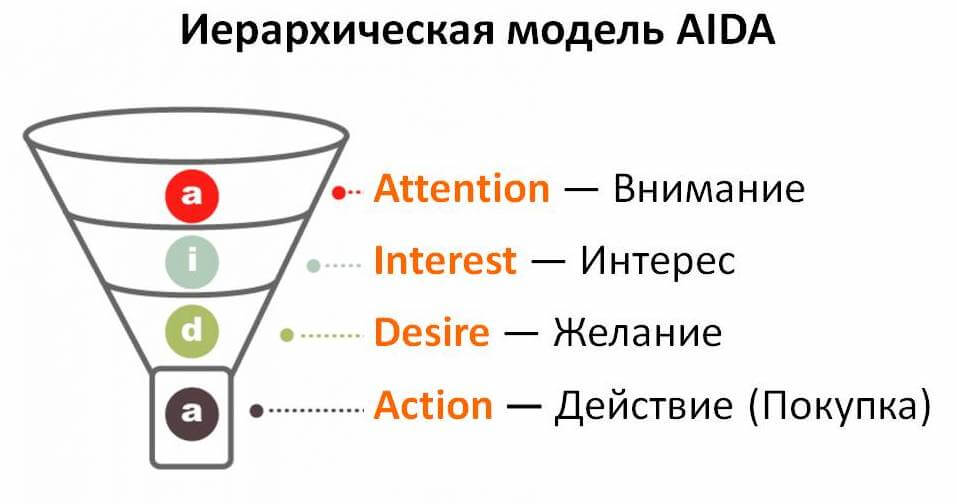
Another rule concerns the "pain" or problems of the buyer. Its meaning is that the selling text should identify these problems and indicate the right way to solve them - the very action that a person who visits the site must take.
For example, the user needs high-quality and inexpensive winter shoes for the whole family. He types a query in the search bar: "winter shoes for the whole family inexpensively." Having received several positions in the search results, he visits one of the first sites and reads the text.
What he learned from him convinces the user that it is in this online store that the best shoes at affordable prices are just right for the whole family, and even at a discount.
Perhaps the text will be so convincing that a potential buyer will not look for anything else, but will immediately order delivery. But there is one catch. A potential buyer will get to the site and read this text only if it is noticed by search engines and placed on the first page of the issue.
This means that the SEO copywriter faces another equally important task - optimizing the text for the requirements of search engines.
Content optimization
When it comes to SEO copywriting, then this task should be considered the main one. If the content does not appear in the top lines of the issue, then the quality of the text will not help here, just few people will see and read it.
Requests and keys
The requirements for SEO text are varied, and we will talk about them below, but now we will focus on working with keywords, which is considered the main activity of an SEO copywriter.
The user requests themselves, from which the keys are taken, are of four types:
high frequency- these are the most frequently encountered requests that can have several tens of thousands of impressions per month. Most often they are short in one or two words, for example, “repair”, “cottage”, “books on psychology”, “laptop”, etc. On the one hand, there are many users with these queries. On the other hand, the competition is very high. It is very difficult to break into the TOP by high-frequency keys.
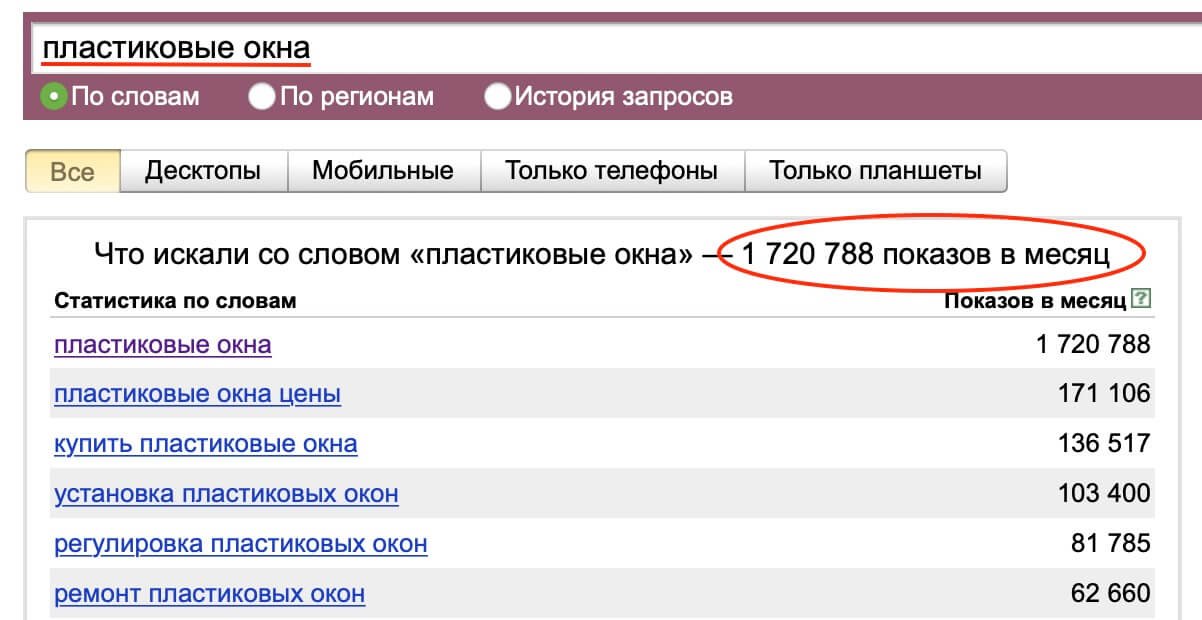 high frequency requests. It is very difficult to move on them. No specifics.
high frequency requests. It is very difficult to move on them. No specifics. midrange more specific queries, longer and less frequently asked. For example: “download books on psychology”, “how to write a selling text”, “repair of plastic windows”.
 An example of a more specific request. The number of requests has dropped significantly.
An example of a more specific request. The number of requests has dropped significantly. Low frequency. They are even rarer because of the even greater specification of the request. For example, “free download books on the psychology of thinking”, “do-it-yourself plastic window repair”. Promoting a site using these keywords is both dangerous and profitable. On the one hand, search engines register few impressions, on the other hand, your buyer will definitely get to the site, and not a “passing by” random visitor.
 Low-frequency queries are the most valuable.
Low-frequency queries are the most valuable. longtail(long tails) - very long queries, due to additions and clarifications, they do not even get into the search line. For example: "Buy cheap Swiss watches wholesale in Ivanovo with delivery." To enter such a key into the text, the SEO copywriter must be a real virtuoso.
Various query options allow you to combine their wording in the text, which at least slightly facilitates the work of an SEO copywriter.
How to enter keys
But how to enter low-frequency, and even more so “long tails”? You can do this in different ways, there are several options for entering:
- Direct. The key word or phrase should be used exactly, unchanged, without punctuation marks.
- Diluted. The key phrase can be broken up with punctuation marks and prepositions.
- Morphological. Assumes the ability to change the form of words, for example, cases. For example, not "buy a Swiss watch", but "buy a Swiss watch".
- Reverse. You are allowed to change words.
It is important to evenly distribute keywords throughout the text, but sometimes the first paragraphs are considered priority. It is they who first of all "catch the eye" of search robots.
You should not get too carried away with keywords, as this does not improve the quality of the text and can cause overspam, which has a bad effect on content promotion.
Experienced specialists believe that the number of keywords should not exceed 3-5% of the text volume.
Where to find the keys
In general, searching for keys and compiling the semantic core of the site is not the responsibility of an SEO copywriter. This is usually done by an optimizer or "seoshnik" - an SEO specialist.
But this is ideal, but in reality anything happens, and knowing where to find the keys is not superfluous for a SEO copywriter.
The easiest way to find the wording of key queries is by setting your topic in a search engine. You will get a whole list of search suggestions.
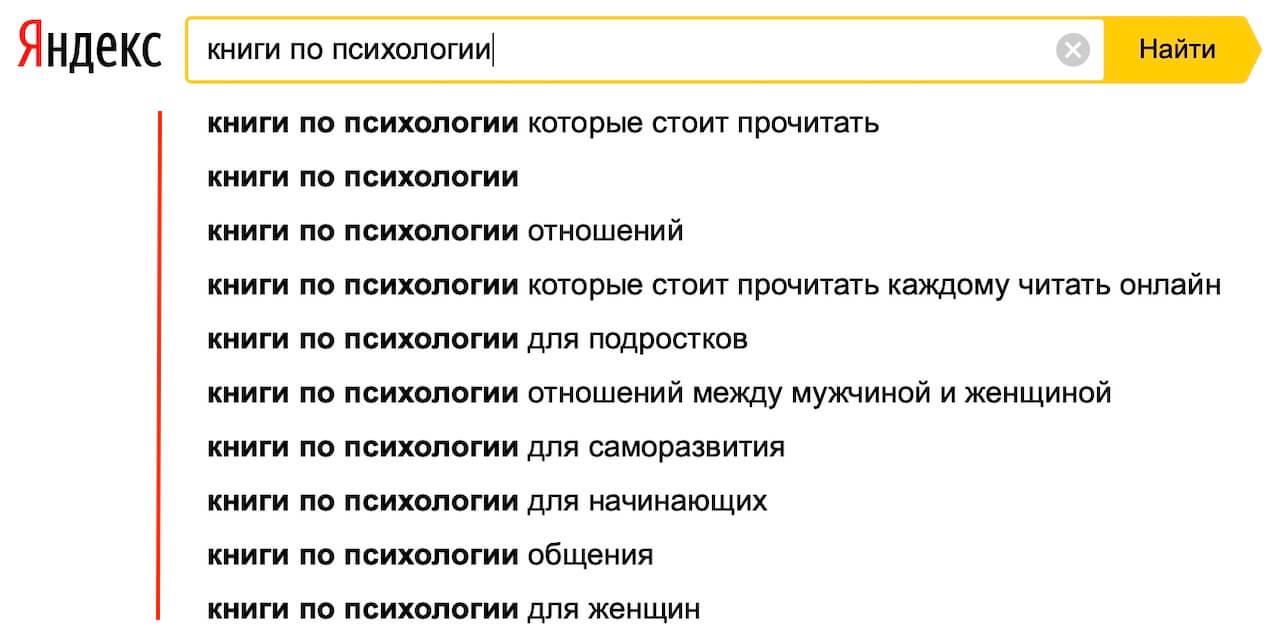
But there are special services for working with search query statistics. These are, for example, wordstat.yandex.ru and AdWords in Google. To determine the frequency of a request and search for keys close to it, it is enough to set the main topic. For example:
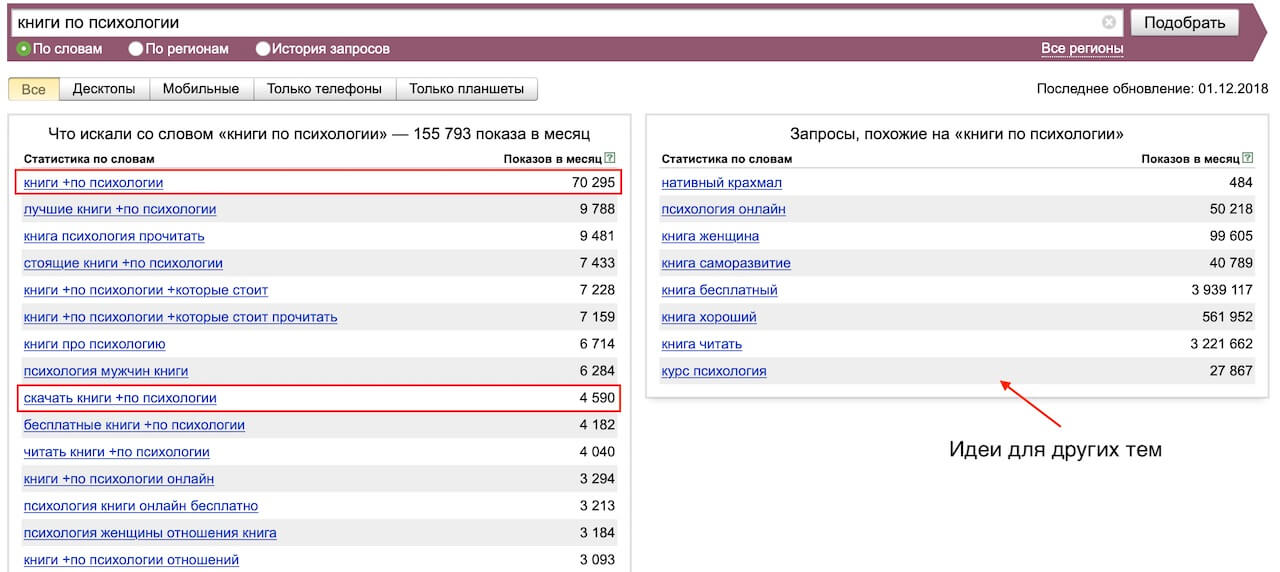
Please note that the high-frequency query "books on psychology" gives 70 thousand impressions per month, and the middle-frequency query "download books on psychology" already only 4 thousand. And if you click on this line, you will get even more low-frequency queries.
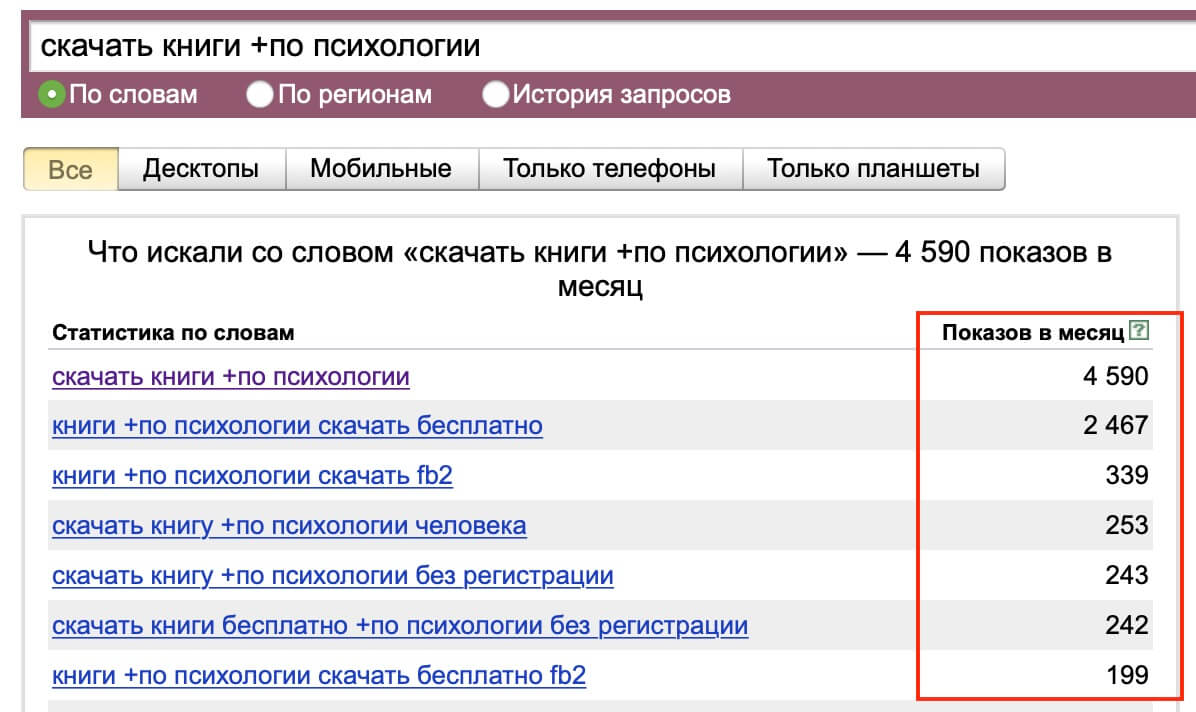
There are also other options for keys that can be used in the text. Well, let the more difficult work of selecting keys remain on the conscience of the “seoshnik”.
Text for people
So we got to the third task of an SEO copywriter. Yet texts are written for people, and not only because they are more important than search robots, but also because SEO copywriting should take into account the behavioral factor.
If the text is not interesting to the site visitor, he will quickly leave it and go looking for more useful content. This will lead to several negative consequences:
- the site owner will lose a potential buyer or user;
- a decrease in visitors (leads) will reduce the chance of business success;
- User abandonment will worsen the performance of the site and lower its ranking in search engines.
Thus, SEO copywriting is an activity related to combining the incompatible: optimizing the text based on key queries and creating interesting and useful content that attracts users.
 Follow the bounce rate in Yandex Metrica. The smaller it is, the better.
Follow the bounce rate in Yandex Metrica. The smaller it is, the better. This requires a SEO copywriter to have a high mastery of the word. In addition, there are a number of serious requirements for SEO text.
What should be the SEO text
There are general requirements that any author must comply with if he respects his readers. Its text should be literate, logical, informative, have a “readable” style and correspond to the stated topic.
But SEO texts are special, since search robots evaluate not only the presence of keywords, but also a number of other indicators, and recently these indicators have been given increasing importance.
Uniqueness. The text must be original, not rewritten from what is already available on the Internet, but created by the author on the basis of a serious processing of his experience and a large amount of various information.
That is, it should be copywriting, not rewriting. , which check it for plagiarism (copying other people's texts).
The most popular such services include anti-plagiarism programs of copywriter exchanges eTXT, Text.ru and Advego. The uniqueness of 95-100% is considered high, the average - from 85%. A lower percentage of uniqueness seriously affects not only the quality of the text, but also the prospects for its promotion in search engines.
Structured. The text presented on the site should have a clear structure and be divided into subheadings of different levels. They are denoted by HTML tags h2, h3, h4, and the title of the article - tag H1. Numbered and bulleted lists are also welcome.
Lack of "water". . The level of “water content” of the content can also be checked, for example, using the Text.ru anti-plagiarism program.

The absence of spam, that is, a glut of text with repetitive words and phrases. As you can see, the same TEXT.ru program, after checking the text for uniqueness, will also show the percentage of water in it. Repetitions harm any content in general, and in SEO texts they are often associated with an overabundance of keywords.
SEO training
In order for the site to be in the top positions in the search results and bring consistently high income, you need to be able to understand SEO. You won't be able to master this topic right off the bat.
You can write articles for your website or blog for years, but not get visitors to it. Unfortunately, this is a common occurrence among beginners.
There are two ways.
First. Learn to search for information on the net and check it on your project. This method is very long and it is not a fact that something will work out at all.
Second. Get trained by experts in the SEO field and get real results in the shortest possible time. I myself am constantly learning and spend tens of thousands of rubles on SEO courses. My task is to make money on my blog, and not just for the pleasure of writing and posting articles. Therefore, I choose the fastest way to my goal through training.
You also need to understand that not all courses will benefit. Since there are too many people on the Internet who “pour water” and do not teach anything. From myself I can recommend 2 courses. If you really learn, then only from the best.
- SEO specialist from Netology.
- SEO specialist from GeekBrains and Mail.ru
The most important thing about these courses is that you will not be “thrown” into free swimming after passing, but will be helped to complete an internship and even get a job. The average salary of an SEO specialist is 70,000 rubles per month.

In custody
As you can see, the requirements for SEO texts are very extensive, as well as the tasks facing their creators. Therefore, high-quality SEO copywriting is not cheap.
True, in recent years there have been major changes in the algorithms of search engines. And among the criteria for ranking texts, their usefulness for users, information content and uniqueness come first.
But this does not mean that the work of an SEO copywriter will be less in demand. Indeed, in addition to the ability to use key queries to optimize content, this specialist has the skills to create high-quality articles on various topics, taking into account all the requirements of search engines.
And the SEO copywriter honed his writing skills, beautifully inscribing keys into the text, often with the most crazy wording.
